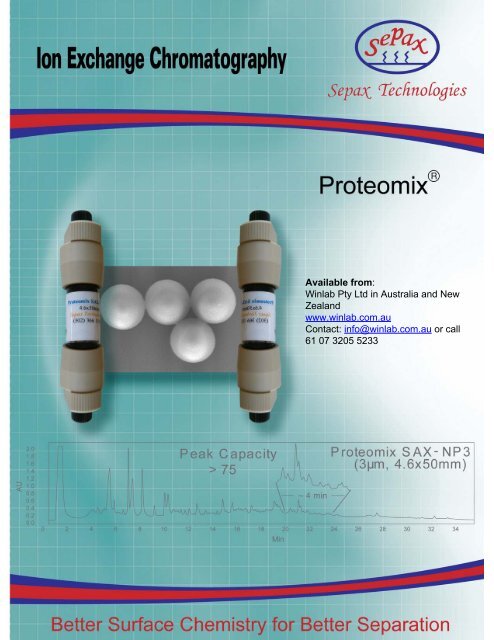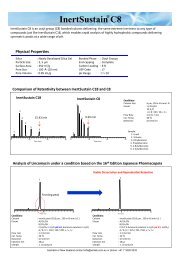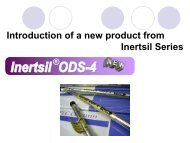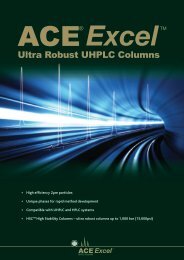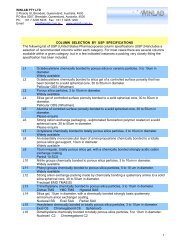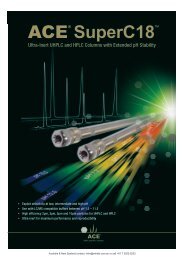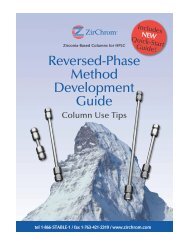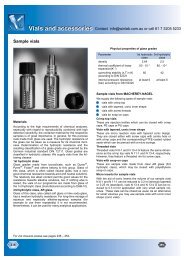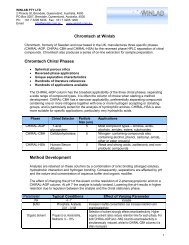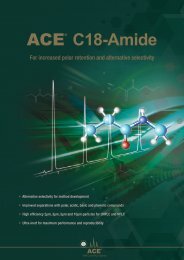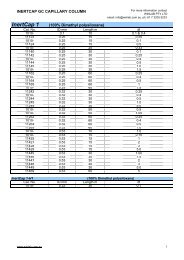Sepax Proteomix Brochure - Winlab.com.au
Sepax Proteomix Brochure - Winlab.com.au
Sepax Proteomix Brochure - Winlab.com.au
- No tags were found...
Create successful ePaper yourself
Turn your PDF publications into a flip-book with our unique Google optimized e-Paper software.
<strong>Proteomix</strong> ® Ion-exchange PhasesGeneral Description<strong>Proteomix</strong> ion-exchange columns are specially designed forhigh resolution, high efficiency and high recoveryseparations of proteins, oligonucleotides, carbohydrates,and peptides. The packing support is <strong>com</strong>posed of a rigid,spherical, highly cross-linked poly(styrene divinylbenzene)(PS/DVB) bead. Both porous and non-porous PS/DVBbeads are provided. The porous PS/DVB resins haveparticle sizes of 5 and 10 µm with the pore size of 500 Å.The non-porous resins have particle sizes of 1.7, 3, 5 and10 µm. The PS/DVB resin surface is grafted with a highlyhydrophilic, neutral polymer layer with the thickness in therange of nanometer. The hydrophobic PS/DVB resin surfaceis totally covered by such a hydrophilic coating thateliminates non-specific bindings with biological analytes,leading to high efficiency and high recovery separations forbiomolecules. On the top of the hydrophilic layer, a layer ofion-exchange functional groups is attached via chemicalbonding. A proprietary chemistry was developed tosynthesize a densely packed, uniform ion-exchange layer.Chemical Structure of <strong>Proteomix</strong> ResinsThe chemical structure of <strong>Proteomix</strong> ion-exchange phasesis <strong>com</strong>posed of a rigid PS/DVB core, a densely packed,nanometer thick, hydrophilic coating, and a uniform ionexchangelayer, as shown in Figure 1.Hydrophilic LayerModifiedPS/DVBIon-Exchange GroupFig. 1. Schematic illustration of the chemical structure of<strong>Proteomix</strong> ion-exchange phases.Protomix Ion-Exchange PhasesAs shown in Figure 2, <strong>Proteomix</strong> ion-exchange phases are<strong>com</strong>posed of SCX, WCX, SAX, and WAX, which are strongcation exchanger with sulfonate functional groups, weakcation exchanger with carboxylate functional groups, stronganion exchanger with quaternary ammonium functionalgroups, weak anion exchanger with tertiary aminefunctional, respectively. All ion-exchange functional groupsare chemically bonded to the top of the hydrophilic coatingfor both porous and non-porous PS/DVB resins.SCXHO 3 S—WCXHOOC—SAX⊕—N(CH 3 ) 3WAX—N(C 2 H 5 ) 2Fig. 2. Chemical <strong>com</strong>positions of <strong>Proteomix</strong> SCX, WAX, SAX,and WAX phases.Highlights of <strong>Proteomix</strong> Non-Porous IonexchangeResins• Combined high capacity and high separation efficiency inone material• Particle size selection of 1.7, 3, 5 and 10 µm• Mono-dispersed particles• Tolerate high pressure operation: 4,000, 6,000, 8,000 and12,000 psi for 10, 5, 3 and 1.7 µm resins, respectively• Wide pH range: 2-12• High resolving power for slightly differed structures ofbiological species• 1.7 and 3 µm particles are best suitable for whole proteinseparation in proteome studies• Suitable for separations of peptides, carbohydrates andglycans, proteins, polynucleotides, cell lysates and multidimensionalseparationswww.sepax-tech.<strong>com</strong> 2 1-877-SEPAX-US
Non-Porous <strong>Proteomix</strong> Ion-exchangers– Technology AdvancementsHigh Capacity of <strong>Proteomix</strong> Non-Porous ResinsIt is well known that the non-porous resin maximizes themass transfer and minimizes the lateral diffusion, resultingin high speed and high efficiency separations. However, dueto the low surface area, the separation capacity is low. Thelow capacity issue creates a great challenge to the nonporousresins for many applications. The <strong>Proteomix</strong> nonporousion-exchange resins developed by <strong>Sepax</strong> proprietarytechnologies have a breakthrough on the improvement oftheir capacities. This new technology enables the capacityof the non-porous resins increased to the level <strong>com</strong>parableto that of the porous resins. Figure 3 shows examples ofdynamic binding capacities of the 3 µm non-porous<strong>Proteomix</strong> SAX and WAX resins: 35 and 26 mg/mL,respectively. Figure 4 shows an example of the dynamicbinding capacity of 3 µm <strong>Proteomix</strong> SCX non-porous resin.Its dynamic binding capacity reaches as high as 53.5mg/mL.High dynamic binding capacity leads to high sample loadingwithout deterioration of the separation efficiency and theresolution. Figure 5 shows the elution of cytochrome C withthe loading up to 200 µg for a 1.7 µm <strong>Proteomix</strong> SCX nonporouscolumn without any deterioration of the separation.AUFig. 4. The dynamic binding capacity test for <strong>Proteomix</strong> SCX-NP3 resin by flowing lysozyme into the column.mAU150010005000<strong>Proteomix</strong> SCX-NP3(3µm, 4.6x50 mm)Capacity: 53.5 mg/mL5 10 15 20 25 30minMobile Phase: 10 mM phosphate, pH 6.0Flow Rate: 0.5 mL/minDetection: 280 nmTemperature: 25 o CSample: Lysozyme (3 mg/mL)Fig. 5. Elution profiles of cytochrome C at various loadings.2.01.81.61.41.21.00.8SCX-NP1.7 (1.7µm, 4.6x50mm)200 µg100 µgFig. 3. The dynamic binding capacity tests for <strong>Proteomix</strong> anionexchangeresins by flowing BSA into the columns.0.60.40.20 4 8 12 16 20Min50 µg(A) <strong>Proteomix</strong> WAX-NP3(3µm, 4.6x50 mm)0.015 16 17 18 19 20 21 22Minutes(B) <strong>Proteomix</strong> SAX-NP3(3µm, 4.6x50 mm)Dynamic Binding Capacity• SAX-NP3: 35 mg/mL• WAX-NP3: 26 mg/mLABColumn: <strong>Proteomix</strong> SCX-NP1.7 (1.7 µm, 4.6x50 mm)Mobile Phase: A, 20 mM PBS, pH 6.0; B, A+1.0 M NaClGradient: 0-70%B (21 min)Flow Rate: 0.35 mL/minDetection: 280 nmTemperature: 25 o CSample: Cytochrome C (20 mg/mL)5 10 15 20 25 30 35minColumn: 4.6x50 mmMobile Phase: 10 mM Tris/HCl, pH 8.0Flow Rate: 0.25 mL/minDetection: 280 nmTemperature: 25 o CSample: BSA (3 mg/mL)High Separation Efficiency, Resolution and Selectivity<strong>Proteomix</strong> SCX-NP, WCX-NP, SAX-NP, and WAX-NPresins have three unique features. First, their nanometerthick hydrophilic layer <strong>com</strong>pletely eliminates the non-specificinteractions with the biological analytes. Second, nonporousbeads minimize the biological analytes’ lateraldiffusion and suppress their diffusion into thechromatographic bed. Third, a uniform layer of ionexchangefunctional groups synthesized by <strong>Sepax</strong>’sproprietary technology greatly improved their ion-exchangewww.sepax-tech.<strong>com</strong> 3 1-877-SEPAX-US
capacities. Such innovatively designed <strong>Proteomix</strong> SCX-NP,WCX-NP, SAX-NP, and WAX-NP phases result in thehighest efficiency separations for proteins, oligonucleotides,carbohydrates, and peptides. Figure 6 is a typical testchromatogram for separation of three proteins: ribonucleaseA, cytochrome C, and lysozyme by a 4.6 × 50 mm,<strong>Proteomix</strong> SCX-NP column (3 µm). The efficiency oflysozyme reaches 100,000 of plates with 5 cm long column.Such a high efficiency separation is unprecedented.Fig. 6. Separation of a protein mixture by a <strong>Proteomix</strong> SCX-NPcolumn.Fig. 7. The elution profile of lysozyme from its multipleimpurities by a <strong>Proteomix</strong> SCX-NP column (3 µm, 4.6 × 50 mm).The separation conditions are the same as those in Fig. 6.541/236mAU1006.375111.065Fig. 8. Elution profile of a mixture of ovalbumin and BSA by<strong>Proteomix</strong> SAX-NP5 column.8060407.27323mAUOvalbuminBSA2040002 4 6 8 10 12 14min2000Column: <strong>Proteomix</strong> SCX-NP3 (3 µm, 4.6x50 mm)Mobile phase: A, 10 mM phosphate, pH 6.0B, A + 1.0 M NaClGradient: 0-70%B in 15 minFlow rate: 0.5 mL/minSample: 1) Cytochrome C, 2) Ribonuclese A,3) LysozymeInjection: 5 µL (1 mg/mL for each protein)Temperature: 25 o CDetection: UV 280 nmThe uniqueness of non-porous <strong>Proteomix</strong> SCX, WCX, SAX,and WAX phases offers highest resolution and selectivity forprotein separations. Figure 7 shows an elution profile oflysozyme by a <strong>Proteomix</strong> SCX-NP3 phase (3 µm). Sixpeaks are well resolved with a short column (4.6 × 50 mm).Such a high selectivity and resolving power is unmatchedwith any other SCX phases.0 2 4 6 8 10 12 14minColumn: <strong>Proteomix</strong> SAX-NP5 (5 µm, 4.6x50 mm)Mobile phase: A, 20 mM Tris, pH 8.0B, A + 0.5 M NaClGradient: 0-50%B in 15 minFlow rate: 0.5 mL/minSample: 1) Ovalbumin (10 mg/mL), 2) BSA (5mg/mL)Injection: 10 µLTemperature: 25 o CDetection: UV 214 nmFigure 8 is a typical test chromatogram for a 5 µm,<strong>Proteomix</strong> SAX-NP column for separation of a mixture ofovalbumin and BSA. High resolution and high selectivity of<strong>Proteomix</strong> SAX-NP phase can well separate the impuritiescontained in ovalbumin sample, as well as the BSA dimerfrom BSA.www.sepax-tech.<strong>com</strong> 4 1-877-SEPAX-US
Particle Size Impact on the SeparationThe smaller the particle size, the better separation efficiencyand higher separation speed. <strong>Proteomix</strong> ion-exchangeresins have a wide range of the particle size selection from1.0 to 10 µm for analytical and semi-preparative separationapplications. Figure 9 is the separation of three proteins byfour weak cation exchange resins with the particle size of1.7, 3, 5, and 10 µm, separately. It is clearly seen that thesmaller particle generates higher efficiency and resolution.One of the impurities in lysozyme labeled by Peak N isbarely separated with10 µm WCX resin. For 5 µm WCXresin, it is almost a baseline separation. When the particlesize is decreased to 3 µm, it be<strong>com</strong>es a baselineseparation. With the particle size further decreased to 1.7µm, the impurity is well separated.Fig. 9. Separation of a protein mixture by <strong>Proteomix</strong> WCX-NPcolumns with various particle sizes.Charge Dependent SeparationFigure 10 is a typical test chromatogram for a <strong>Proteomix</strong>SCX-NP column (3 µm). Extremely high efficiencyseparation was achieved for 5 proteins. Those proteinswere eluted based on their charge status (pI) from low tohigh: ovalbumin, ribonuclease A, cytochrome C, aprotinin,and lysozyme. At the separation conditions (pH 6.0),ovalbumin is negatively charged and eluted at the voidvolume, indicating no non-specific bindings.Fig. 10. Separation of a protein mixture with various pI by a<strong>Proteomix</strong> SCX column.ProteinspI1. Ovalbumin 4.62. Ribonuclease A 8.73. Cytochrome C 9.64. Aprotinin 10.05. Lysozyme 11.012<strong>Proteomix</strong> WCX-NP(4.6x50mm)mAU12534043301.7 µm3 µm5 µm10 µmPeak N20100 2 4 6 8 10 12 14 16 18 20 22Min2 4 6 8 10 12minColumn: <strong>Proteomix</strong> WCX-NP (4.6x50 mm)Mobile phase: A, 10 mM phosphate, pH 6.0B, A + 1.0 M NaClGradient: 0-100%B in 20 minFlow rate: 1.0 mL/min, 0.75 mL/min for WCX-NP1.7Sample: 1) Cytochrome C, 2) Ribonuclese A,3) LysozymeInjection: 5 µL (1 mg/mL for each protein)Temperature: 25 o CDetection: UV 280 nmColumn: <strong>Proteomix</strong> SCX-NP3 (3 µm, 4.6x50 mm)Mobile phase: A, 10 mM phosphate, pH 6.0B, A + 1.0 M NaClGradient: 0-100%B in 15 minFlow rate: 0.5 mL/minInjection: 5 µL (1 mg/mL for each protein)Temperature: 25 o CDetection: UV 280 nmwww.sepax-tech.<strong>com</strong> 5 1-877-SEPAX-US
High Lot-to-Lot ReproducibilityWith well-controlled resin production and the surfacechemistry, the manufacturing of the <strong>Proteomix</strong> ionexchangersis highly reproducible. The typical variation ofthe retention time is less than 6% from batch to batch. Oneexample is shown in Figure 11 for the production of threelots of 3 µm <strong>Proteomix</strong> SAX-NP resins.Fig. 11. The reproducibility of three lots of <strong>Proteomix</strong> SAX resins.<strong>Proteomix</strong> SAX-NP3Lot ALot BLot COvalbuminBSAPorous Protomix Ion-Exchanger<strong>Proteomix</strong> SCX-POR, WCX-POR, SAX-POR, and WAX-POR resins are based on porous PS/DVB resins that arecoated with a proprietary hydrophilic layer andfunctionalized with a uniform ion-exchange layer. Thesephases have three unique features. First, the nanometerthick hydrophilic layer <strong>com</strong>pletely eliminates the non-specificinteractions with biological analytes. Second, <strong>Sepax</strong>’sproprietary technology synthesizes a uniform and denselypacked layer of ion-exchange functional groups. Third,porous beads provide high surface area, leading to highseparation capacity. Such uniquely designed <strong>Proteomix</strong>SCX-POR, WCX-POR, SAX-POR, and WAX-POR phasesoffer high capacity and reasonably high resolutionseparations for proteins, oligonucleotides and peptides.Due to the porosity, <strong>Proteomix</strong> porous resins have lessefficiency and lower resolution than <strong>Proteomix</strong> non-porousresins. <strong>Proteomix</strong> SCX-POR, WCX-POR, SAX-POR, andWAX-POR phases are well suited for semi-preparative andpreparative separation and purification of biomolecules.Porous <strong>Proteomix</strong> SCX, WCX, SAX, and WAX columns aremanufactured and tested under the strictest specifications,resulting in high column-to-column and lot-to-lotreproducibility.0 2 4 6 8 10 12 14minColumn Dimension AvailabilityColumn: <strong>Proteomix</strong> SAX-NP3 (3 µm, 4.6x50 mm)Mobile phase: A, 20 mM Tris, pH 8.0B, A + 0.3 M NaClGradient: 0-100%B in 15 minFlow rate: 0.5 mL/minSample: 1) Ovalbumin (10 mg/mL), 2) BSA (5mg/mL)Injection: 10 µLTemperature: 25 o CDetection: UV 214 nmMono-dispersed<strong>Proteomix</strong> ionexchangeparticlesenable uniform columnpacking bed, whichimproves separationefficiency.The column dimensions of the <strong>Proteomix</strong> SCX, WCX, SAX,and WAX products are 0.75, 2.1, 3.0, 4.6, 7.8, 10, and 21.2mm I.D., and 2, 3, 5, 10, 15, 25, and 30 cm length. <strong>Sepax</strong>also offers custom-made columns.Features Uniform polymer beads as the packing support Proprietary surface chemistry specially designed forelimination of non-specific bindings Unprecedented separation efficiency, selectivity andresolving power Complete selection for analytical, semi-preparative andpreparative separations Wide particle size selection High stability High recovery Well suited for UPLC systemwww.sepax-tech.<strong>com</strong> 6 1-877-SEPAX-US
Technical SpecificationsProducts Pore Size Particle Size (µm) Dynamic binding capacity pH range<strong>Proteomix</strong> SCX-NP1.7, NP3, NP5 & NP10 Non-porous 1.7, 3, 5, 10 ~60, 54, 38, and 20 mg/mL 2-12<strong>Proteomix</strong> SCX-POR10 500 Å 10 ~35 mg/mL 2-12<strong>Proteomix</strong> WCX-NP1.7, NP3, NP5 & NP10 Non-porous 1.7, 3, 5, 10 ~25, 19, 15 and 10 mg/mL 2-12<strong>Proteomix</strong> WCX-POR10 500 Å 10 ~22 mg/mL 2-12<strong>Proteomix</strong> SAX-NP1.7, NP3, NP5 & NP10 Non-porous 1.7, 3, 5, 10 ~43, 35, 28, and 17 mg/mL 2-12<strong>Proteomix</strong> SAX-POR10 500 Å 10 ~25 mg/mL 2-12<strong>Proteomix</strong> WAX-NP1.7, NP3, NP5 & NP10 Non-porous 1.7, 3, 5, 10 ~35, 26, 18, and 12 mg/mL 2-12<strong>Proteomix</strong> WAX-NOR10 500 Å 10 ~20 mg/mL 2-12ApplicationsSeparation and AnalysisProteinsCell lysatesNucleic acidsSeparation of Horse Serum, a Protein MixtureFigure 12 shows the separation of a horse serum by using<strong>Proteomix</strong> SAX-NP5 and a <strong>com</strong>mercial porous SAX column.Non-porous <strong>Proteomix</strong> SAX-NP5 has much high resolutionthan the porous SAX column.Fig. 12. The separation of a horse serum (20 µL, 2x diluted) fromBioWhittaker, a Cambrex <strong>com</strong>pany (Walkersville, MD).(Courtesy of Miyako Kawakatsu, M&S Instruments, Inc.)PeptidesCarbohydrates and glycansNucleotidesNanoparticlesNanotubes<strong>Proteomix</strong> ion-exchange phases have wide applications forseparation, identification and purification of proteins, proteinvariants, peptide fragments, phosphorylated, sialylated, andother derivatized proteins. They are excellent for monitoringenzymatic reactions and protein-protein interactions. Withextremely high separation efficiency, <strong>Proteomix</strong> phases arewell designed for proteomics applications and 2D or multidimensionalseparations. One example is the highresolution of cell lysates by <strong>Proteomix</strong> SAX-NP phases.<strong>Proteomix</strong> SAX and WAX phases are suitable for separationof oligonucleotides. Porous <strong>Proteomix</strong> ion-exchange phasesprovide high resolution and high capacity separation forsurface charged nanoparticles, nanorods and nanotubes.Porous SAX Column X(5 µm, 4.6x150 mm)<strong>Proteomix</strong> SAX-NP5(5 µm, 4.6x150 mm)Mobile phase: (A) 25 mM Tris acetate, pH 7.3(B) A + 0.8 M sodium acetateGradient: 0-50%-70%B (0-25-28 min)Flow rate: 0.5 mL/min for SAX-NP51.0 mL/min for Porous SAXDetection: UV 280 nmwww.sepax-tech.<strong>com</strong> 7 1-877-SEPAX-US
Separation of Carbohydrates and GlycansFigure 13 shows the separation of glucose oligomers andcorn starch hydrolysate. ELSD is utilized to detectcarbohydrate molecules. For ELSD detection, bleeding is abig problem for most columns, especially silica based aminocolumns. However, <strong>Proteomix</strong> SAX columns not only solvedthe bleeding problem, but also achieved excellentseparation efficiency and resolution. Figure 14 is anotherexample of high resolution separation of glycans and theirisomers by non-porous <strong>Proteomix</strong> SAX column.Fig. 13. Separation of glucose oligomers and corn starchhydrolysate by <strong>Proteomix</strong> SAX-NP5 phase. (Courtesy of MiyakoKawakatsu, M&S Instruments, Inc.)Starch hydrolysate (5 µL)Glucose oligomer (G1-G6)(5 µL)B, 0.5% acetic acid in ACNGradient: 0-100%B (60 min)Flow rate: 0.3 mL/minDetection: Fluorescence Ex/Em=360/425nmSample: G0F: asialo, agalacto, core-fucosylated biantennaryglycan; G1F: asialo, mono-galacto, core-fucosylated biantennaryglycan; G2F: asialo, di-galacto, core-fucosylated biantennaryglycan; SA1F: mono-sialylated, galactosylated, core-fucosylatedbiantennary glycan; SA2F: di-sialylated, galactosylated, corefucolylatedbiantennary glycan; NGNA: N-glycolylneuraminicacid.Separation of Peptides in Volatile BufferThe peptides with different hydrophobicity can be resolvedby reversed phases, such as C18. However, peptides withdifferent charges may not be well separated on reversedphase mode if their hydrophobic properties are close. As analternative method, ion exchange chromatography isre<strong>com</strong>mended. With the net charge from +1 to +4, fourpeptides (C1, C2, C3 and C4 with their sequences listed inFigure 15) were well separated by <strong>Proteomix</strong> SCX-NPphase in a volatile buffer of ammonium acetate andacetonitrile, which makes it <strong>com</strong>patible for LC/MSapplication.Fig. 15. Cation exchange separation of 4 peptides C1, C2, C3 andC4 (0.1 mg/mL). (Courtesy of Miyako Kawakatsu, M&SInstruments, Inc.)C1C3Column: <strong>Proteomix</strong> SAX-NP5 (5 µm, 4.6x150 mm)Mobile phase: A, 0.05% (25% NH 4 OH) in CH 3 CNB, 0.05% (25% NH 4 OH) in H 2 OGradient: 15-80%B (20 min)Flow rate: 0.7 mL/minSample: Corn starch hydrolysateTemperature: 35 o CDetection: ELSDC2C4SofTA@280nmFig. 14. Separation of 2-AA (anthranilic acid) labeled N-linkedoligosaccharides profiling of an IgG1 sample.LU4003002001000G0FG1FIsomer of G1FG2FIsomers of SA1F (NGNA)SA2F(NGNA)20 30 40 50 60minColumn: <strong>Proteomix</strong> SAX-NP5 (5 µm, 4.6x150 mm)Mobile phase: A, 2.5% (v/v) acetic acid, 0.5% TEA in H 2 OColumn: <strong>Proteomix</strong> SCX-NP3 (3 µm, 4.6x50 mm)Mobile phase: A, 5 mM CH 3 COONH 4B, 500 mM CH 3 COONH 4 :CH 3 CN=4:1(v/v)Gradient: 0-50%B (20 min)Flow rate: 0.6 mL/minTemperature: 25 o CDetection: ELSDInjection: 5 µL (0.1 mg/mL)Sample: Peptides C1, C2, C3 and C4Peptide Sequence Net ChargeC1 Ac-Gly-Gly-Gly-Leu-Gly-Gly-Ala-Gly-Gly-Leu-Lys-amide +1C2C3C4Ac-Lys-Tyr-Gly-Leu-Gly-Gly-Ala-Gly-Gly-Leu-Lys-amide +2Ac-Gly-Gly-Ala-Leu-Lys-Ala-Leu-Lys-Gly-Leu-Lys-amide +3Ac-Lys-Tyr-Ala-Leu-Lys-Ala-Leu-Lys-Gly-Leu-Lys-amide +4minwww.sepax-tech.<strong>com</strong> 8 1-877-SEPAX-US
High Protein Loading SeparationRibonuclease A was separated by a non-porous SCXcolumn. When the injection amount of Ribonuclease A wasincreased from 50 µg to 5 mg, the separation resolution hadnegligible change and each of the impurities was wellseparated, as shown in Figure 16. The <strong>com</strong>bination of highloading capacity and high resolution separation enablesnon-porous <strong>Proteomix</strong> ion-exchange columns very wellsuited for both analytical and preparative separations ofbiological molecules.example of high resolution separation of oligonucleotides ofMw 12196 from its degraded fragments. At least 35 speciesof those degraded oligo fragments were well resolved within22 minutes.Fig. 17. Separation a 50-mer oligonucleotide from its impuritiesby non-porous <strong>Proteomix</strong> SAX and porous SAX columns.(A) <strong>Proteomix</strong> SAX-NP5Fig. 16. Elution profiles of RNaseA by <strong>Proteomix</strong> SCX-NP3column with various loadings. (Courtesy of Miyako Kawakatsu,M&S Instruments, Inc.)(B) Porous SAX Column X20 22.5 25 27.5 30 32.5 35 37.5 40minColumn: 4.6x150 mm (5 µm)Mobile phase: A, 25 mM Tris, pH 9; B, A + 1.0 M LiClGradient: 30-75%B in 45 minFlow rate: 1.0 mL/minSample: 50-mer OligoInjection: 50 µLDetection: UV 260 nmColumn: <strong>Proteomix</strong> SCX-NP3 (3 µm, 4.6x50 mm)Eluent: 10 mM PBS, pH 6.0Gradient: 0-1.0 M NaCl (20 min)Flow rate: 1.0 mL/minDetection: 280 nm;Temperature: 25 o CInjection: 100 µLSample: Ribonuclease A (from Bovine Pancreas forGenomics, Wako Pure Chemical industries, Ltd.)Separation of OligonucleotidesHigh resolution separation is critical for DNA analysis andpurification. The non-porous <strong>Proteomix</strong> SAX resins offerhigh separation efficiency with high capacity. Figure 17shows the separation of a 50-mer oligonucleotidesynthesized by ABI synthesizer. The largest peak is themodified 50-mer oligo and the others are failures or theimpurities. As a <strong>com</strong>parison, the same sample wasseparated with a <strong>com</strong>mercial porous SAX column. Theresults showed similar retention time for the 50-meroligonucleotide from both non-porous and porous SAXcolumns, which indicated that their capacities are close toeach other. However, the non-porous SAX generated muchhigher efficiency and resolution. Figure 18 is anotherFig. 18. Separation of an oligonucleotide (MW 12196) and itsdegraded fragments.AU0.100.080.060.040.020.0016 18 20 22 24 26 28 30 32 34 36 38 40MW 12196-0.020 4 8 12 16 20 24 28 32 36 40 44MinColumn: <strong>Proteomix</strong> SAX-NP5 (5 µm, 4.6x150 mm)Mobile phase: A, 25 mM Tris, 1.0 mM EDTA, 10% ACN,pH 8.0; B, A+1.0 M NaClGradient: 0-75%B in 50 minFlow rate: 0.5 mL/minSample: Oligonucleotide and its degraded fragmentsInjection: 50 µLwww.sepax-tech.<strong>com</strong> 9 1-877-SEPAX-US
Separation and Analysis of Cell LysatesThe key issue for proteome studies is to separate andidentify a large number of biological species in a cell, suchas proteins, nucleotides, peptides and others. The demandfor separation is unprecedented. With the uniqueness ofhigh resolution and high capacity, the non-porous <strong>Proteomix</strong>ion-exchange resins are very much suitable for separatingcell lysates. Figure 19(a) showed the separation profiles ofE. coli lysate with 3, 5, and 10 µm non-porous <strong>Proteomix</strong>SAX particles. The minimum number of resolved peaksincreased from 40 to 60 to 75 when the particle sizedecreased from 10 to 5 to 3 µm. To better view theseparation performance, the elution profiles in the range of10-22 minutes were shown in Figure 19(b). At least 45, 38,27 peaks were resolved at the retention time of 10-22minutes for 3, 5, and 10 µm SAX columns, respectively.Figure 20 showed various sample loading for a 3 µm,4.6x50 mm non-porous SAX column. When the amount ofE. coli lysate increased from 25 µg to 50 µg to 125 µg, theseparation efficiency and resolution remained consistent.Fig. 19(a) (Top). Separation of E. coli lysate by 3, 5 and 10 µm<strong>Proteomix</strong> SAX particles. (b) (Bottom). Expanded region ofretention time from 10 to 22 min.<strong>Proteomix</strong> SAX-NP10(10 µm, 4.6x50 mm)Peak Capacity > 40<strong>Proteomix</strong> SAX-NP5(5 µm, 4.6x50 mm)Peak Capacity > 60Column: <strong>Proteomix</strong> SAX-NP (4.6x50 mm)Mobile phase: A, 20 mM Tris, pH 9.0; B, A + 0.5 M NaClGradient: 0-100%B in 30 minFlow rate: 0.5 mL/minSample: E. coli lysate (2.5 mg/mL)Injection: 10 µLTemperature: 25 o CDetection: UV 280 nmFig. 20. Elution profile of E. coli Lysate by non-porous <strong>Proteomix</strong>SAX column with various loadings. The separation conditions arethe same as those in Fig. 19.<strong>Proteomix</strong> TM SAX-NP3 (3µm, 4.6x50mm)E. coli Lysate(2.5 mg/mL)Injection50 µL20 µL10 µL18 19 20 21Min0 2 4 6 8 10 12 14 16 18 20 22 24 26 28 30 32 34MinFig. 21. High peak capacity separation of yeast lysate by nonporous<strong>Proteomix</strong> SAX column. (Courtesy of Prof. Fred Regnier,Purdue University)1.2Peak capacity is at least 50<strong>Proteomix</strong> SAX-NP3(3 µm, 4.6x50 mm)Peak Capacity > 700 2 4 6 8 10 12 14 16 18 20 22 24 26 28 30 32 34Min1.00.8AU0.60.4-1 min-<strong>Proteomix</strong> SAX-NP10 (10 µm)0.2<strong>Proteomix</strong> SAX-NP5 (5 µm)0.00.0 2.5 5.0 7.5 10.0 12.5 15.0 17.5 20.0 22.5 25.0 27.5 30.0 32.5 35.0 37.5 40.0 42.5 45.0Min<strong>Proteomix</strong> SAX-NP3 (3 µm)10 11 12 13 14 15 16 17 18 19 20 21 22MinColumn: <strong>Proteomix</strong> SAX-NP3 (3 µm, 4.6x50 mm)Mobile phase: A, 20 mM Tris, pH 9.0; B, A + 0.5 M NaClGradient: 0-100%B in 30 minFlow rate: 0.5 mL/minSample: Yeast lysate (2.5 mg/mL)Injection: 40 µLTemperature: 25 o CDetection: UV 280 nmwww.sepax-tech.<strong>com</strong> 10 1-877-SEPAX-US
<strong>Proteomix</strong> SCX-NP ColumnsPrice list of <strong>Proteomix</strong> Ion-Exchange ColumnsPhaseID x Length(mm)P/N Price PhaseID x Length(mm)P/NPrice1.7 µm<strong>Proteomix</strong>SCX-NP1.75 µm<strong>Proteomix</strong>SCX-NP57.8 x 50 401NP2-7805 $1350 7.8 x 50 401NP3-7805 $11954.6 x 150 401NP2-4615 $1350 4.6 x 150 401NP3-4615 $11954.6 x 100 401NP2-4610 $1250 4.6 x 100 401NP3-4610 $10954.6 x 50 401NP2-4605 $1050 4.6 x 50 401NP3-4605 $9504.6 x 30 401NP2-4603 $975 4.6 x 30 401NP3-4603 $9004.0 x 10 (Guard) 401NP2-4001 $425 3 µm 4.0 x 10 (Guard) 401NP3-4001 $3753.0 x 100 401NP2-3010 $1150 <strong>Proteomix</strong> 3.0 x 100 401NP3-3010 $10953.0 x 50 401NP2-3005 $1025 SCX-NP3 3.0 x 50 401NP3-3005 $9503.0 x 30 401NP2-3003 $950 3.0 x 30 401NP3-3003 $9002.1 x 100 401NP2-2110 $1095 2.1 x 100 401NP3-2110 $10952.1 x 50 401NP2-2105 $950 2.1 x 50 401NP3-2105 $9502.1 x 30 401NP2-2103 $900 2.1 x 30 401NP3-2103 $9002.0 x 10 (Guard) 401NP2-2001 $4252.0 x 10 (Guard) 401NP3-2001 $37510 x 250 401NP5-10025 Inquire 10 x 250 401NP10-10025 Inquire7.8 x 250 401NP5-7825 $2150 7.8 x 250 401NP10-7825 $17507.8 x 100 401NP5-7810 $1275 7.8 x 150 401NP10-7815 $10507.8 x 50 401NP5-7805 $1150 7.8 x 50 401NP10-7805 $8754.6 x 250 401NP5-4625 $1250 4.6 x 250 401NP10-4625 $10504.6 x 150 401NP5-4615 $1150 4.6 x 150 401NP10-4615 $8754.6 x 100 401NP5-4610 $1050 4.6 x 100 401NP10-4610 $7504.6 x 50 401NP5-4605 $95010 µm4.6 x 50 401NP10-4605 $4754.6 x 30 401NP5-4603 $875 <strong>Proteomix</strong> 4.6 x 30 401NP10-4603 $3754.0 x 10 (Guard) 401NP5-4001 $325 SCX-NP10 4.0 x 10 (Guard) 401NP10-4001 $2752.1 x 150 401NP5-2115 $1150 2.1 x 150 401NP10-2115 $9752.1 x 100 401NP5-2110 $1050 2.1 x 100 401NP10-2110 $7552.1 x 50 401NP5-2105 $950 2.1 x 50 401NP10-2105 $4752.1 x 30 401NP5-2103 $850 2.1 x 30 401NP10-2103 $3752.0 x 10 (Guard) 401NP5-2001 $325 2.0 x 10 (Guard) 401NP10-2001 $275Preparative ColumnsPreparative Columns21.2 x 250 401NP5-21225 Inquire 21.2 x 250 401NP10-21225 Inquire21.2 x 150 401NP5-21215 Inquire21.2 x 150 401NP10-21215 Inquire<strong>Proteomix</strong> WCX-NP ColumnsPhaseID x Length(mm)P/N Price PhaseID x Length(mm)P/NPrice1.7 µm<strong>Proteomix</strong>WCX-NP1.77.8 x 50 402NP2-7805 $1350 7.8 x 50 402NP3-7805 $11954.6 x 150 402NP2-4615 $1350 4.6 x 150 402NP3-4615 $11954.6 x 100 402NP2-4610 $1250 4.6 x 100 402NP3-4610 $10954.6 x 50 402NP2-4605 $1050 4.6 x 50 402NP3-4605 $9504.6 x 30 402NP2-4603 $975 4.6 x 30 402NP3-4603 $9004.0 x 10 (Guard) 402NP2-4001 $425 3 µm 4.0 x 10 (Guard) 402NP3-4001 $3753.0 x 100 402NP2-3010 $1150 <strong>Proteomix</strong> 3.0 x 100 402NP3-3010 $10953.0 x 50 402NP2-3005 $1025WCX-NP33.0 x 50 402NP3-3005 $9503.0 x 30 402NP2-3003 $950 3.0 x 30 402NP3-3003 $9002.1 x 100 402NP2-2110 $1095 2.1 x 100 402NP3-2110 $10952.1 x 50 402NP2-2105 $950 2.1 x 50 402NP3-2105 $9502.1 x 30 402NP2-2103 $900 2.1 x 30 402NP3-2103 $9002.0 x 10 (Guard) 402NP2-2001 $4252.0 x 10 (Guard) 402NP3-2001 $375www.sepax-tech.<strong>com</strong> 11 1-877-SEPAX-US
PhaseID x Length((mm)P/N Price PhaseID x Length(mm)P/NPrice5 µm<strong>Proteomix</strong>WCX-NP510 x 250 402NP5-10025 Inquire 10 x 250 402NP10-10025 Inquire7.8 x 250 402NP5-7825 $2150 7.8 x 250 402NP10-7825 $17507.8 x 100 402NP5-7810 $1275 7.8 x 150 402NP10-7815 $10507.8 x 50 402NP5-7805 $1150 7.8 x 50 402NP10-7805 $8754.6 x 250 402NP5-4625 $1250 4.6 x 250 402NP10-4625 $10504.6 x 150 402NP5-4615 $1150 4.6 x 150 402NP10-4615 $8754.6 x 100 402NP5-4610 $1050 4.6 x 100 402NP10-4610 $7504.6 x 50 402NP5-4605 $95010 µm4.6 x 50 402NP10-4605 $4754.6 x 30 402NP5-4603 $875 <strong>Proteomix</strong> 4.6 x 30 402NP10-4603 $3754.0 x 10 (Guard) 402NP5-4001 $325 WCX-NP10 4.0 x 10 (Guard) 402NP10-4001 $2752.1 x 150 402NP5-2115 $1150 2.1 x 150 402NP10-2115 $9752.1 x 100 402NP5-2110 $1050 2.1 x 100 402NP10-2110 $7552.1 x 50 402NP5-2105 $950 2.1 x 50 402NP10-2105 $4752.1 x 30 402NP5-2103 $850 2.1 x 30 402NP10-2103 $3752.0 x 10 (Guard) 402NP5-2001 $325 2.0 x 10 (Guard) 402NP10-2001 $275Preparative ColumnsPreparative Columns250 × 21.2 402NP5-21225 Inquire 21.2 x 250 402NP10-21225 Inquire150 × 21.2 402NP5-21215 Inquire21.2 x 150 402NP10-21215 Inquire<strong>Proteomix</strong> SAX-NP ColumnsPhaseID x Length(mm)P/N Price PhaseID x Length(mm)P/NPrice1.7 µm<strong>Proteomix</strong>SAX-NP1.75 µm<strong>Proteomix</strong>SAX-NP57.8 x 50 403NP2-7805 $1350 7.8 x 50 403NP3-7805 $11954.6 x 150 403NP2-4615 $1350 4.6 x 150 403NP3-4615 $11954.6 x 100 403NP2-4610 $1250 4.6 x 100 403NP3-4610 $10954.6 x 50 403NP2-4605 $1050 4.6 x 50 403NP3-4605 $9504.6 x 30 403NP2-4603 $975 4.6 x 30 403NP3-4603 $9004.0 x 10 (Guard) 403NP2-4001 $425 3 µm 4.0 x 10 (Guard) 403NP3-4001 $3753.0 x 100 403NP2-3010 $1150 <strong>Proteomix</strong> 3.0 x 100 403NP3-3010 $10953.0 x 50 403NP2-3005 $1025 SAX-NP3 3.0 x 50 403NP3-3005 $9503.0 x 30 403NP2-3003 $950 3.0 x 30 403NP3-3003 $9002.1 x 100 403NP2-2110 $1095 2.1 x 100 403NP3-2110 $10952.1 x 50 403NP2-2105 $950 2.1 x 50 403NP3-2105 $9502.1 x 30 403NP2-2103 $900 2.1 x 30 403NP3-2103 $9002.0 x 10 (Guard) 403NP2-2001 $4252.0 x 10 (Guard) 403NP3-2001 $37510 x 250 403NP5-10025 Inquire 10 x 250 403NP10-10025 Inquire7.8 x 250 403NP5-7825 $2150 7.8 x 250 403NP10-7825 $17507.8 x 100 403NP5-7810 $1275 7.8 x 150 403NP10-7815 $10507.8 x 50 403NP5-7805 $1150 7.8 x 50 403NP10-7805 $8754.6 x 250 403NP5-4625 $1250 4.6 x 250 403NP10-4625 $10504.6 x 150 403NP5-4615 $1150 4.6 x 150 403NP10-4615 $8754.6 x 100 403NP5-4610 $1050 4.6 x 100 403NP10-4610 $7504.6 x 50 403NP5-4605 $95010 µm4.6 x 50 403NP10-4605 $4754.6 x 30 403NP5-4603 $875 <strong>Proteomix</strong> 4.6 x 30 403NP10-4603 $3754.0 x 10 (Guard) 403NP5-4001 $325 SAX-NP10 4.0 x 10 (Guard) 403NP10-4001 $2752.1 x 150 403NP5-2115 $1150 2.1 x 150 403NP10-2115 $9752.1 x 100 403NP5-2110 $1050 2.1 x 100 403NP10-2110 $7552.1 x 50 403NP5-2105 $950 2.1 x 50 403NP10-2105 $4752.1 x 30 403NP5-2103 $850 2.1 x 30 403NP10-2103 $3752.0 x 10 (Guard) 403NP5-2001 $325 2.0 x 10 (Guard) 403NP10-2001 $275Preparative ColumnsPreparative Columns21.2 x 250 403NP5-21225 Inquire 21.2 x 250 403NP10-21225 Inquire21.2 x 150 403NP5-21215 Inquire21.2 x 150 403NP10-21215 Inquirewww.sepax-tech.<strong>com</strong> 12 1-877-SEPAX-US
<strong>Proteomix</strong> WAX-NP ColumnsPhase1.7 µm<strong>Proteomix</strong>WAX-NP1.75 µm<strong>Proteomix</strong>WAX-NP5ID x Length(mm)P/N Price PhaseID x Length(mm)7.8 x 50 404NP2-7805 $1350 7.8 x 50 404NP3-7805 $11954.6 x 150 404NP2-4615 $1350 4.6 x 150 404NP3-4615 $11954.6 x 100 404NP2-4610 $1250 4.6 x 100 404NP3-4610 $10954.6 x 50 404NP2-4605 $1050 4.6 x 50 404NP3-4605 $9504.6 x 30 404NP2-4603 $975 4.6 x 30 404NP3-4603 $9004.0 x 10 (Guard) 404NP2-4001 $4253 µm4.0 x 10 (Guard) 404NP3-4001 $3753.0 x 100 404NP2-3010 $1150<strong>Proteomix</strong>3.0 x 100 404NP3-3010 $10953.0 x 50 404NP2-3005 $1025 WAX-NP3 3.0 x 50 404NP3-3005 $9503.0 x 30 40NP2-3003 $950 3.0 x 30 404NP3-3003 $9002.1 x 100 404NP2-2110 $1095 2.1 x 100 404NP3-2110 $10952.1 x 50 404NP2-2105 $950 2.1 x 50 404NP3-2105 $9502.1 x 30 404NP2-2103 $900 2.1 x 30 404NP3-2103 $9002.0 x 10 (Guard) 404NP2-2001 $425P/NPrice2.0 x 10 (Guard) 404NP3-2001 $37510 x 250 404NP5-10025 Inquire 10 x 250 404NP10-10025 Inquire7.8 x 250 404NP5-7825 $2150 7.8 x 250 404NP10-7825 $17507.8 x 100 404NP5-7810 $1275 7.8 x 150 404NP10-7815 $10507.8 x 50 404NP5-7805 $1150 7.8 x 50 404NP10-7805 $8754.6 x 250 404NP5-4625 $1250 4.6 x 250 404NP10-4625 $10504.6 x 150 404NP5-4615 $1150 4.6 x 150 404NP10-4615 $8754.6 x 100 404NP5-4610 $1050 4.6 x 100 404NP10-4610 $7504.6 x 50 404NP5-4605 $950 4.6 x 50 404NP10-4605 $47510 µm4.6 x 30 404NP5-4603 $875 4.6 x 30 404NP10-4603 $375<strong>Proteomix</strong>4.0 x 10 (Guard) 404NP5-4001 $325 4.0 x 10 (Guard) 404NP10-4001 $275WAX-NP102.1 x 150 404NP5-2115 $1150 2.1 x 150 404NP10-2115 $9752.1 x 100 404NP5-2110 $1050 2.1 x 100 404NP10-2110 $7552.1 x 50 404NP5-2105 $950 2.1 x 50 404NP10-2105 $4752.1 x 30 404NP5-2103 $850 2.1 x 30 404NP10-2103 $3752.0 x 10 (Guard) 404NP5-2001 $325 2.0 x 10 (Guard) 404NP10-2001 $275Preparative ColumnsPreparative Columns21.2 x 250 404NP5-21225 Inquire 21.2 x 250 404NP10-21225 Inquire21.2 x 150 404NP5-21215 Inquire21.2 x 150 404NP10-21215 Inquire<strong>Proteomix</strong> SCX-POR ColumnsPhaseID x Length(mm )P/N Price PhaseID x Length(mm )P/NPrice<strong>Proteomix</strong>SCX-POR5(5 µm, 500 Å)7.8 x 250 405505-7825 $1950 10 x 250 405509-10025 Inquire4.6 x 250 405505-4625 $1250 7.8 x 250 405509-7825 $17504.6 x 150 405505-4615 $1150 4.6 x 250 405509-4625 $11504.6 x 100 405505-4610 $1050 4.6 x 150 405509-4615 $10504.6 x 50 405505-4605 $950 <strong>Proteomix</strong> 4.6 x 100 405509-4610 $9504.6 x 30 405505-4603 $875 SCX-POR10 4.6 x 50 405509-4605 $8504.0 × 10 (Guard) 405505-4001 $325 (10 µm) 4.0 x 10 (Guard) 405509-4001 $2752.1 x 150 405505-2115 $1150 (500 Å) 2.1 x 250 405509-2125 $11502.1 x 100 405505-2110 $1050 2.1 x 150 405509-2115 $10502.1 x 50 405505-2105 $950 2.1 x 100 405509-2110 $9502.1 x 30 405505-2103 $875 2.1 x 50 405509-2105 $8502.0 × 10 (Guard) 405505-2001 $3252.0 x 10 (Guard) 405509-2001 $275www.sepax-tech.<strong>com</strong> 13 1-877-SEPAX-US
<strong>Proteomix</strong> WCX-POR ColumnsPhaseID x Length(mm )P/N Price PhaseID x Length(mm )P/NPrice<strong>Proteomix</strong>WCX-POR5(5 µm, 500 Å)7.8 x 250 406505-7825 $1950 10 x 250 406509-10025 Inquire4.6 x 250 406505-4625 $1250 7.8 x 250 406509-7825 $17504.6 x 150 406505-4615 $1150 4.6 x 250 406509-4625 $11504.6 x 100 406505-4610 $1050 4.6 x 150 406509-4615 $10504.6 x 50 406505-4605 $950 <strong>Proteomix</strong> 4.6 x 100 406509-4610 $9504.6 x 30 406505-4603 $875 WCX-POR10 4.6 x 50 406509-4605 $8504.0 x 10 (Guard) 406505-4001 $325 (10 µm) 4.0 x 10 (Guard) 406509-4001 $2752.1 x 150 406505-2115 $1150 (500 Å) 2.1 x 250 406509-2125 $11502.1 x 100 406505-2110 $1050 2.1 x 150 406509-2115 $10502.1 x 50 406505-2105 $950 2.1 x 100 406509-2110 $9502.1 x 30 406505-2103 $875 2.1 x 50 406509-2105 $8502.0 × 10 (Guard) 406505-2001 $3252.0 x 10 (Guard) 406509-2001 $275<strong>Proteomix</strong> SAX-POR ColumnsPhaseID x Length(mm )P/N Price PhaseID x Length(mm )P/NPrice<strong>Proteomix</strong>SAX-POR5(5 µm, 500 Å)7.8 x 250 407505-7825 $1950 10 x 250 407509-10025 Inquire4.6 x 250 407505-4625 $1250 7.8 x 250 407509-7825 $17504.6 x 150 407505-4615 $1150 4.6 x 250 407509-4625 $11504.6 x 100 407505-4610 $1050 4.6 x 150 407509-4615 $10504.6 x 50 407505-4605 $950 <strong>Proteomix</strong> 4.6 x 100 407509-4610 $9504.6 x 30 407505-4603 $875 SAX-POR10 4.6 x 50 407509-4605 $8504.0 x 10 (Guard) 407505-4001 $325 (10 µm) 4.0 x 10 (Guard) 407509-4001 $2752.1 x 150 407505-2115 $1150 (500 Å) 2.1 x 250 407509-2125 $11502.1 x 100 407505-2110 $1050 2.1 x 150 407509-2115 $10502.1 x 50 407505-2105 $950 2.1 x 100 407509-2110 $9502.1 x 30 407505-2103 $875 2.1 x 50 407509-2105 $8502.0 × 10 (Guard) 407505-2001 $3252.0 x 10 (Guard) 407509-2001 $275<strong>Proteomix</strong> WAX-POR ColumnsPhaseID x Length(mm )P/N Price PhaseID x Length(mm )P/NPrice<strong>Proteomix</strong>WAX-POR5(5 µm, 500 Å)7.8 x 250 408505-7825 $1950 10 x 250 408509-10025 Inquire4.6 x 250 408505-4625 $1250 7.8 x 250 4085509-7825 $17504.6 x 150 408505-4615 $1150 4.6 x 250 408509-4625 $11504.6 x 100 408505-4610 $1050 4.6 x 150 408509-4615 $10504.6 x 50 408505-4605 $950 <strong>Proteomix</strong> 4.6 x 100 408509-4610 $9504.6 x 30 408505-4603 $875 WAX-POR10 4.6 x 50 408509-4605 $8504.0 x 10 (Guard) 408505-4001 $325 (10 µm) 4.0 x 10 (Guard) 408509-4001 $2752.1 x 150 408505-2115 $1150 (500 Å) 2.1 x 250 408509-2125 $11502.1 x 100 408505-2110 $1050 2.1 x 150 408509-2115 $10502.1 x 50 408505-2105 $950 2.1 x 100 408509-2110 $9502.1 x 30 408505-2103 $875 2.1 x 50 408509-2105 $8502.0 × 10 (Guard) 408505-2001 $3252.0 x 10 (Guard) 408509-2001 $275www.sepax-tech.<strong>com</strong> 14 1-877-SEPAX-US


